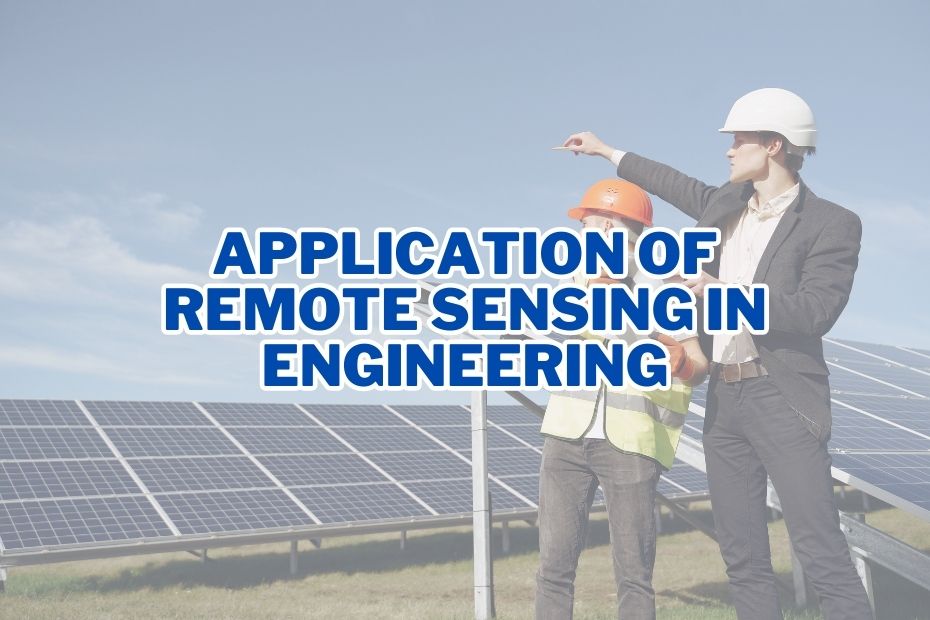In the field of engineering, remote sensing has emerged as a powerful tool for acquiring valuable data and information. By utilizing various imaging techniques, remote sensing enables engineers to gather data from a distance without physically accessing the objects or areas being studied. This article explores 11 different application of remote sensing in engineering, showcasing its versatility and significance in various domains.
The application of remote sensing in engineering is significant, involving the use of satellite or aircraft-based sensor technologies to detect and classify objects on Earth. It is instrumental in areas like civil engineering for monitoring infrastructure health, assessing damages, or planning new projects.
Application of Remote Sensing in Engineering
Remote sensing plays a crucial role in various engineering applications by providing valuable information about the Earth’s surface and its features without direct physical contact. It involves the use of sensors on satellites, aircraft, drones, or ground-based instruments to capture data about the electromagnetic radiation reflected or emitted by objects on the Earth’s surface. Here are some key application of remote sensing in engineering:
1. Urban Planning and Development
Remote sensing plays a vital role in urban planning and development. By analyzing high-resolution satellite images, engineers can monitor land use patterns, assess urban growth, and identify suitable areas for infrastructure development. This information helps in making informed decisions about zoning regulations, transportation networks, and the allocation of resources for sustainable urban development.
2. Environmental Monitoring
Environmental monitoring is crucial for ensuring the health and sustainability of our ecosystems. Remote sensing technologies enable engineers to monitor changes in vegetation, water bodies, and air quality. By analyzing the collected data, they can assess the impact of human activities, identify areas prone to natural disasters, and develop effective strategies for environmental conservation.
3. Structural Health Monitoring
Maintaining the structural integrity of buildings, bridges, and infrastructure is essential for public safety. Remote sensing techniques such as LiDAR (Light Detection and Ranging) and InSAR (Interferometric Synthetic Aperture Radar) provide engineers with detailed information about structural deformations, movement, and vibrations. This data helps in identifying potential risks, planning maintenance, and ensuring the safety of critical structures.
4. Geotechnical Engineering
In geotechnical engineering, remote sensing is used to assess and monitor geological hazards, such as landslides and subsidence. Satellite images and aerial photographs help in mapping terrain features, identifying potential instability, and understanding geological processes. This information assists engineers in designing appropriate foundations, slope stabilization measures, and disaster mitigation strategies.
5. Water Resource Management
Remote sensing techniques provide valuable insights into water resources management. Engineers can monitor water availability, track changes in reservoir levels, and assess the impact of droughts or floods. This data aids in planning irrigation systems, managing water supplies for agriculture, and implementing sustainable water resource strategies.
6. Transportation Infrastructure Planning
Efficient transportation infrastructure is essential for economic development and connectivity. Remote sensing helps engineers in planning transportation networks, analyzing traffic patterns, and assessing the condition of roads and railways. By monitoring and evaluating these factors, engineers can optimize transportation systems, reduce congestion, and enhance safety.
7. Coastal and Ocean Engineering
Coastal and ocean engineering rely on remote sensing to study coastal erosion, sediment transport, and tidal patterns. Satellite imagery and oceanographic sensors provide data on sea surface temperatures, wave heights, and bathymetry. This information aids in designing coastal protection structures, understanding marine ecosystems, and predicting storm surge events.
8. Mining and Mineral Exploration
Remote sensing techniques are extensively used in mining and mineral exploration. Satellite images and hyperspectral sensors can detect mineral signatures, map geological formations, and identify potential mineral deposits. This data assists engineers in planning mining operations, minimizing environmental impacts, and optimizing resource extraction.
9. Agriculture and Crop Monitoring
In the realm of agriculture, remote sensing facilitates crop monitoring and precision farming. By analyzing satellite imagery and multispectral data, engineers can assess crop health, detect nutrient deficiencies, and predict yields. This information helps in optimizing fertilizer application, managing irrigation, and improving overall agricultural productivity.
10. Disaster Management
Remote sensing plays a crucial role in disaster management and emergency response. During natural disasters like earthquakes, floods, or wildfires, engineers can use satellite imagery and aerial surveys to assess damage, map affected areas, and plan relief operations. This data enables efficient allocation of resources, coordination of rescue efforts, and mitigation of future risks.
11. Energy Infrastructure Planning
The planning and development of energy infrastructure heavily rely on remote sensing technologies. Engineers can use aerial photography and satellite imagery to identify suitable locations for renewable energy projects, such as solar farms and wind turbines. By analyzing environmental factors and geographical data, they can optimize energy generation, reduce environmental impacts, and enhance sustainability.
Conclusion
Remote sensing has revolutionized the field of engineering by providing engineers with valuable data and insights. From urban planning to disaster management, its applications are diverse and far-reaching. By harnessing the power of remote sensing, engineers can make informed decisions, optimize resource allocation, and contribute to sustainable development in various domains.
FAQs: Application of Remote Sensing in Engineering
How does remote sensing benefit engineering?
Remote sensing provides engineers with valuable data for various applications, including urban planning, environmental monitoring, structural health monitoring, and disaster management. It helps in making informed decisions, optimizing resources, and enhancing efficiency.
What are some remote sensing techniques used in engineering?
Common remote sensing techniques in engineering include satellite imagery, LiDAR (Light Detection and Ranging), InSAR (Interferometric Synthetic Aperture Radar), and hyperspectral imaging. These technologies capture data from different wavelengths and perspectives to gather detailed information.
Can remote sensing be used for renewable energy planning?
Yes, remote sensing is widely employed in the planning and development of renewable energy projects. It helps engineers identify suitable locations for solar farms, wind turbines, and other renewable energy infrastructure based on environmental factors and geographical data.
Can remote sensing replace on-site inspections in engineering projects?
Remote sensing complements on-site inspections in engineering projects but cannot entirely replace them. On-site inspections provide detailed and context-specific information that may not be captured by remote sensing techniques alone.
